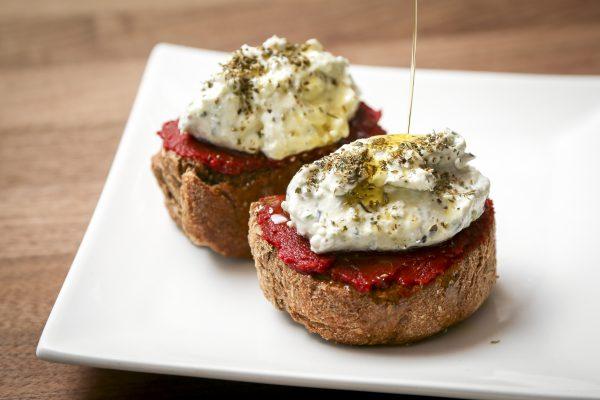Barley Rusks With Tomatoes (Dakos me Pougi)

- 8 small barley rusks
- 3 tablespoons of olive oil, plus more for drizzling
- 3 tablespoons red wine vinegar
- 1/4 to 1/2 cup of organic tomato paste
- 1 8-ounce jar of Loi Feta-Yogurt Pougi
- Dried oregano
Spread a teaspoon (or tablespoon, depending on size of rusk and preference) of tomato paste on top of each barley rusk, and top each with a generous dollop of Loi Feta-Yogurt Pougi.
Stuffed Grape Leaves (Dolmadakia)

Serves 20
- One or two 1-pound jars grape leaves, rinsed and drained (depending on how big you want your dolmadakia, you may need two jars)
- 2 cups Arborio or carnaroli rice
- 1 bunch scallions, minced
- 1 leek (white part only), cleaned thoroughly and finely chopped
- 1 large white onion, minced
- 1 small bunch fresh mint, stemmed and finely chopped
- 1 bunch fresh dill, finely chopped
- 5 tablespoons Greek olive oil
- 1/2 teaspoon grated lemon zest
- 2 tablespoons fresh lemon juice
- Salt and freshly ground black pepper
- 1 medium white onion, chopped
- 1 or 2 lemons, sliced into rounds
- Grape leaves (you’ll have some leftover after rolling the dolmadakia)
- 1 to 2 cups Greek olive oil, depending on size of the dolmadakia
- 1/2 to 1 cup fresh lemon juice, depending on size of the dolmadakia
- 1/2 to 1 cup vegetable broth or water, depending on size of the dolmadakia
Drain the grape leaves and allow them to cool slightly, or run them under cold water so they will cool faster. Remove the end stem pieces from each leaf. Keep the grape leaves covered so they will retain their moisture.
To prepare the filling: In a bowl, combine the rice with lukewarm water to cover and soak for 10 minutes. Drain.
In a large bowl, combine the drained rice, scallions, leek, onion, mint, dill, olive oil, lemon zest, lemon juice, and salt and pepper to taste. Set the rice mixture aside for about 10 minutes so the flavors can blend.
To roll the dolmadakia, arrange the grape leaves, vein side up, on a work surface. Depending on how large you want them to be, place 1 teaspoon or 1 tablespoon of the rice filling at the stem end of each grape leaf. Fold in the two sides of the leaf and roll up to enclose the rice filling. Ideally, the filling will stay in the rolled grape leaves. Repeat until you have used up all the filling and grape leaves.
Preheat the oven to 325 degrees F.
Cannellini Bean Soup (Fasolada)

- 1 pound dried cannellini beans
- 8 cups lukewarm water
- 2 medium red onions, finely chopped
- 1/4 cup olive oil
- 1 red chile pepper, finely chopped
- 2 celery stalks, chopped
- 2 tablespoons finely chopped fresh flat-leaf parsley leaves (no stems), plus more for garnish
- Salt and freshly ground black pepper
On the following day, drain the beans. Add them to a large pot and cover with water. Cook the beans, uncovered, for 30 minutes, skimming the surface occasionally to remove any foam. Drain the beans and discard the cooking water.
Return the beans to the pot, add the lukewarm water, and bring to a boil. Add the onions and olive oil to the pot of beans, stirring to combine. Cook the soup over medium heat, stirring occasionally, for 30 minutes.
Stir in the chile, celery, parsley, and salt and pepper to taste. Continue to boil over medium heat until the beans and vegetables are tender, another 20 minutes.
Chickpea Stew (Sifnos Revithada)

- 1 pound dried chickpeas
- 1 teaspoon baking soda
- 2 medium red onions, finely chopped
- 1/2 cup olive oil
- 1/2 bunch fresh flat-leaf parsley, stemmed and finely chopped
- 1/2 bunch fresh dill, stemmed and finely chopped
- Salt and freshly ground black pepper
- Fresh lemon juice, for serving
Lentil Soup (Fakes)

- Salt and freshly ground black pepper
- 1 pound lentils (any kind, though brown/black are best for this soup)
- 1 medium red onion, finely chopped
- 1 garlic clove, minced
- 2 carrots, sliced into rounds
- 2 tomatoes, grated (on the large holes of a box grater)
- 1 teaspoon tomato paste
- 1 bay leaf
- 1 sprig fresh rosemary
- 1/3 cup olive oil
Loi Greek Yogurt

- 4 1/4 cups organic whole milk
- 1 cup full-fat plain yogurt
Remove the pot from the heat and wait until the temperature drops to 110 degrees Fahrenheit. If you don’t have a thermometer, you can try my grandmother’s old trick to get the right temperature: Keep your pinky in the milk and count quickly to 20; if your pinky is burning at 20, let the milk cool off a bit longer.
Dilute 1 cup of yogurt in the lukewarm milk and stir.
Cover the pot with a blanket to maintain the temperature and keep warm for at least 6 hours. Note that you should not move or shake the pot during this process.
Move the yogurt from the warmth to the refrigerator.
Leave the yogurt for 24 hours in the refrigerator without moving, and your yogurt will be ready to enjoy. It will be good for 10 days, refrigerated.
You can eat the yogurt like this, but if you want to make my grandmother’s authentic recipe, you need to take one more step: Strain the yogurt in cheesecloth and hang to drain for several hours, until the draining stops. This is the real “Loi yogurt” that my grandmother used to make—all the whey is removed. This process adds another week of life to your yogurt.
Make sure you boil and cool the milk at the right temperature.
Don’t be anxious to move the yogurt until it’s ready.
Use high quality milk with no added water, and do not use skim milk.






